Students, teachers and parents struggle to cope.
Vanessa Joy Domingo
When the 2019–2020 school year ended with drive-by graduations, no one knew what to expect for the 2020–2021 school year. At first, the Department of Education released plans where schools would start on August 4 with a variety of scenarios that included most of the students on campus. But when the COVID-19 numbers escalated and with the Hawai‘i State Teachers Association and parents complaining, all plans were thrown out the window.
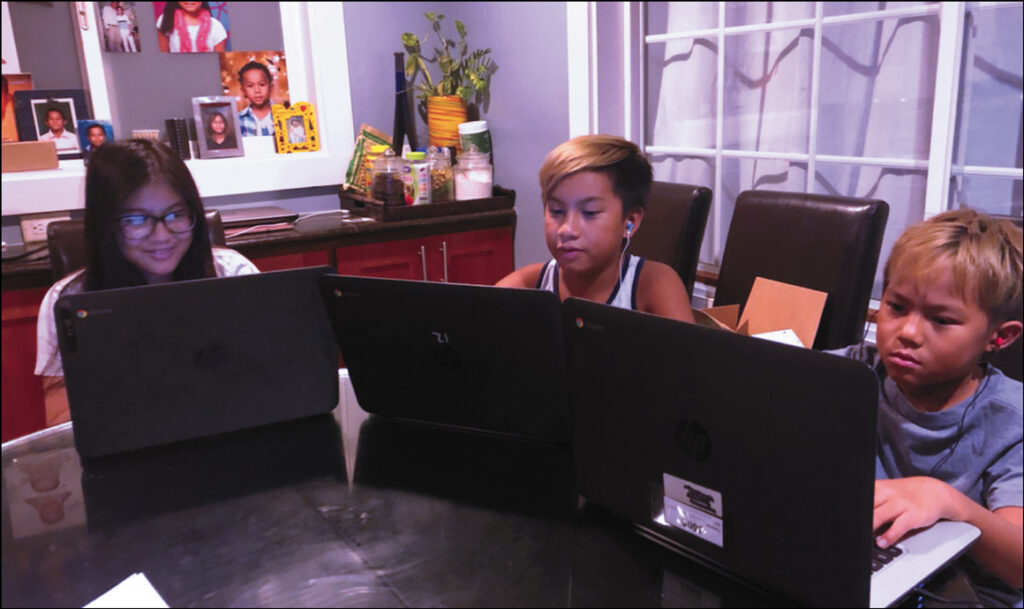
Photo courtesy Lanie Ramirez
Instead, distance learning is the new norm. Although distance learning (also known as virtual learning or online learning) was used during the last two months of the 2019–2020 school year, students, teachers, and parents are still adjusting and learning to cope.

Photo courtesy Julius Galanto
“Most of us were never taught how to teach a virtual class,” said Julius Galanto, a band teacher at ‘Īao School. “Some teachers have gone years and decades teaching in a classroom; very effectively also.”

Photo courtesy Michelle Balala
Kahului Elementary School teacher Michele Balala, like most teachers, is putting in more hours than usual to provide her students with quality education. “I am learning about different apps for learning and how to use them to interact with my students. It definitely feels like my first year of teaching all over again. I’m working well beyond my working hours, like most teachers are, to plan how I’m going to deliver the instruction like I would if it was in person.”

Photo courtesy Ritchilda Yadao
King Kekaulike High School teacher Ritchilda Yadao sympathizes with other teachers adjusting to virtual learning. Yadao has significant experience in teaching virtually through teaching distance learning classes for the University of Hawai‘i at Mānoa College of Education. “For many educators, this is their first attempt at distance learning. It feels like we are all first-year teachers again. We plan, learn new things and adjust, then circumstances beyond our control happen then we find ourselves back to the planning phase. I was not fully prepared to be teaching in this format and I’m still not fully prepared even though we’ve been in session for the past two weeks. But that’s the gift of an educator, we press forward because we are gifted in finding ways to make things work despite the crisis we are in.”

Photo courtesy Judith Hook
Like some teachers who have families, Judith Hook, a fifth grade teacher at Kahului Elementary School, tries to find balance between being a teacher and a parent. “I got her Dad in charge of them with online school. Sadly, I can’t manage them and my class. All school email and notifications go to Jack (Dad).”
The Ramirez family in Kahului experiences a scenario many Maui families can relate to. Jojit and Lanie’s three children—Julia (15 years old), Joseph (12 years old), and Jomel (10 years old) attend different schools. Julia is a sophomore at Maui High school, Joseph is an eighth grader at Maui Waena Intermediate School and Jomel is in fifth grade at Lihikai Elementary School. All three students attend class at the same time from 8 a.m. to 2 p.m. every day. They each have assigned areas in the home to ensure they can focus and not be distracted by each other.
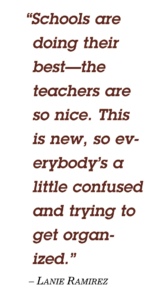 “Julia goes to school online in her room. Joseph takes the boys’ bedroom and Jomel is set up in the kitchen,” explains Jojit. In order to keep up with their children and their studies, Jojit utilizes employee leave made available through the Families First Coronavirus Response Act and takes two days out of the week from his occupation as a Building Maintenance Repairer for the County of Maui. Initially, when schools offered options for blending learning vs virtual learning at home, the parents opted for their children to go to campus. “I’m worried about the COVID-19 pandemic, too,” explained Jojit. “But I don’t feel that it’s great for their mental and emotional health to be at home all the time.” Since then, they’ve tried to supplement their at-home schooling with opportunities to be outside safely with family with activities such as hiking and going to the beach. “Schools are doing their best—the teachers are so nice. This is new, so everybody’s a little confused and trying to get organized,” said Lanie. She is thankful each school was able to provide laptops for her children.
“Julia goes to school online in her room. Joseph takes the boys’ bedroom and Jomel is set up in the kitchen,” explains Jojit. In order to keep up with their children and their studies, Jojit utilizes employee leave made available through the Families First Coronavirus Response Act and takes two days out of the week from his occupation as a Building Maintenance Repairer for the County of Maui. Initially, when schools offered options for blending learning vs virtual learning at home, the parents opted for their children to go to campus. “I’m worried about the COVID-19 pandemic, too,” explained Jojit. “But I don’t feel that it’s great for their mental and emotional health to be at home all the time.” Since then, they’ve tried to supplement their at-home schooling with opportunities to be outside safely with family with activities such as hiking and going to the beach. “Schools are doing their best—the teachers are so nice. This is new, so everybody’s a little confused and trying to get organized,” said Lanie. She is thankful each school was able to provide laptops for her children.

Photo courtesy Lanie Ramirez
For the three Ramirez children, distance learning is not ideal. Julia who is also an AVID (Advancement Via Individual Determination) student says she doesn’t really enjoy going to school online. “I have a short attention span and I’m easily distracted. Just like my classmates, it’s easy to go on your phone and do other stuff while the teacher is talking. I see my classmates get distracted on the screen. I learn better in person and being face-to-face with my teacher.” Julia feels uncomfortable having the camera on but doesn’t feel concerned about any type of bullying happening in class since Google Meetings are monitored. At times, the Wi-Fi can be an issue for her and her siblings. “I have to share the Wi-Fi with my two brothers that are also attending class. So, sometimes there’s a lag. Maybe the schools need to figure out a better way to have online meetings, especially for families that have other siblings that need to be online at the same time.” With a positive mindset, she shares a piece of advice for students her age. “I know it’s hard but keep trying.”
Joseph feels the same way about their internet situation at home. “Sometimes there’s a lag with the Wi-Fi. It’s confusing to be in school at home. You can’t ask the teacher for help with assignments because we don’t have much contact with them.” Joseph observes several of his classmates are not paying attention in class as they are either not looking at the computer, moving around their mouse and occasionally making a funny face on screen. Like Julia, Joseph misses seeing his friends and learning things physically in class. His advice to schools is to provide better internet to families. And to people his age, he encourages them to focus more.
Jomel believes school is not so bad. “Everything is ok—not everyone pays attention though. You can see them doing other stuff during class. It doesn’t feel like school.” Jomel misses hanging out with friends and math class. His advice to schools? “Let us go back to school!” he says.
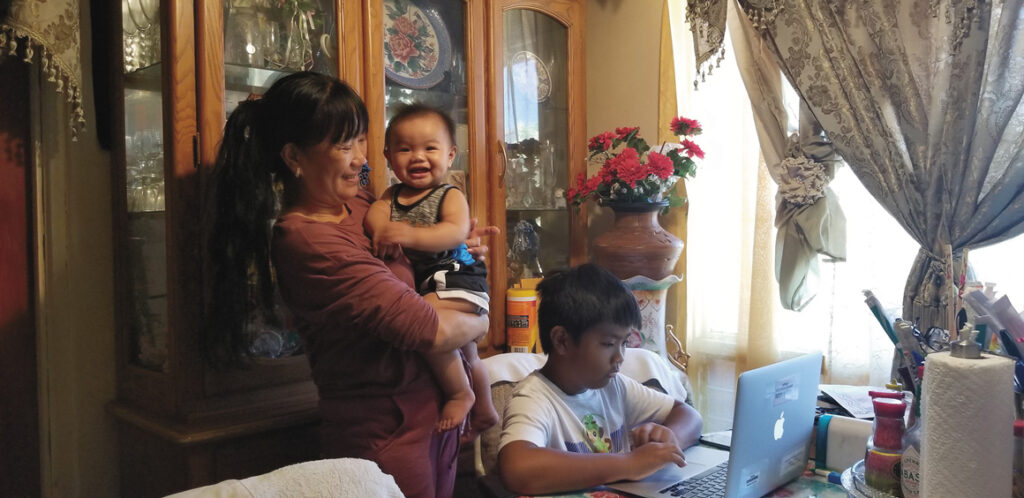
Another predicament encountered by Maui families is finding structure for at-home schooling with both parents working. Fortunately/unfortunately, I have first-hand experience with this situation. My nephew Aaron Jrae Arrocena (AJ) is dropped off around 6 a.m. at his Grandma’s house before his Mom Jenilee goes to work as his Dad Arnel leaves for work by 4:30 a.m. AJ attends Kahului Elementary school and received a laptop to help him with his studies. Because Grandma’s house does not have Wi-Fi, AJ utilizes a mobile hotspot set up by his Mom. In a matter of ten school days, AJ used 40 GB of data, requiring Mom to pay an additional $35 for a data boost of 15 GB so AJ can attend school without interruption. One morning, however, AJ’s mobile hotspot ran out of data. AJ rushed to come look for me in the back cottage, frantic about being disconnected to his class.
Thankfully, I was working from home and was able to assist. But AJ’s experience raises a lot of questions. If I wasn’t home, would AJ have connected to our home Wi-Fi? Would he have found the router and entered the password? Many grandparents are trying to help while both parents are working but can you imagine grandma and grandpa trying to troubleshoot internet connectivity problems?
Outside distractions are also a problem. After thirty minutes that AJ was with me (I am now his favorite Aunty), our neighbors began arguing. I moved AJ into another room of the house so he could focus and not be distracted. While AJ was trying to focus and tune out the noise the next door, I heard his teacher address one of the students in the classroom—“Please put away your toy. When class is in session, we don’t play with our toys.” The students chime in as the teacher proceeds with the lessons. But even AJ experiences some hurdles on his end. “Sorry, I can’t hear you, AJ. Can you speak louder for me?” “I’m sorry,” the teacher says to another student. “You looked like you were raising your hand.” He had called on her to answer a question and explained that she couldn’t give him the answer.
My brief experience with AJ has led me to conclude learning at home is not always the appropriate environment. How do you ensure optimal Wi-Fi so there’s no lag in this virtual environment? How do you handle noise that is beyond your control? How do you properly teach students about posture, focus, and appropriate classroom behavior? When something goes wrong—who can be there to help the student?

Photo courtesy Danny Acidera
The problems with the internet holds true for other islands. Maui boy Danny Acidera who now teaches third grade at Haha‘ione Elementary School in Hawai‘i Kai on O‘ahu says “The biggest challenge with meeting students online is connecting. I mean this in both definitions, digitally and personally. Sometimes students’ Wi-Fi or online programs have glitches, causing a disruption in the flow of learning. Connecting personally with students online is not as meaningful as being in person. I think live social interaction between students and their teachers is absolutely necessary for a child’s education and mental health.”
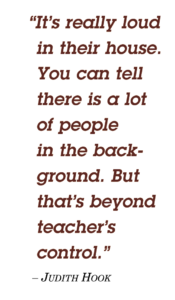 Hook agrees there is still definitely room for improvement in providing the optimal class setting. “I give minor reminders to make sure they are in a learning space where they can focus and to make sure that if they’re not speaking to have their microphones off. There are one-to-two students that I repeat the reminders to. During another student’s presentation of their All About Me PowerPoint, the same two students did not have a quiet space to focus in or have their microphones off as instructed. It’s really loud in their house. You can tell there is a lot of people in the background. But that’s beyond teacher’s control,” Hook explains. “For some students, you can hear chickens, though,” she adds, chuckling.
Hook agrees there is still definitely room for improvement in providing the optimal class setting. “I give minor reminders to make sure they are in a learning space where they can focus and to make sure that if they’re not speaking to have their microphones off. There are one-to-two students that I repeat the reminders to. During another student’s presentation of their All About Me PowerPoint, the same two students did not have a quiet space to focus in or have their microphones off as instructed. It’s really loud in their house. You can tell there is a lot of people in the background. But that’s beyond teacher’s control,” Hook explains. “For some students, you can hear chickens, though,” she adds, chuckling.
Balala has had a few hiccups with getting in touch with families of her second-grade class. “It has been difficult reaching some families who no longer have working phone numbers or internet connection. The school is working on getting mobile hotspots for these families. Some families are having a difficult time adjusting to this new normal and it is understandable. I try my best to help them as much as I can.”
“Luckily students have been able to connect with me and attendance has not been an issue,” Hook says. “Internet connection hasn’t been a big issue except that I may lag here and there so I have to limit what resources I use during my instruction. I like to use short videos either to introduce or review a lesson and we ran into connection problems,” she adds.
Like the other Kahului School faculty members, Hook is required to teach her curriculum from her classroom. To effectively manage her class, she split them into two groups, having one set meet on Monday and Thursdays and the other half on Tuesdays and Fridays. “I figure Internet/bandwidth would be better. So on days students don’t have live instruction, they are completing independent practice assignments. Wednesdays are reserved for teacher PDs and meetings so these days for students are also Independent workdays—getting assignments done from the previous day of instruction.”
Hook’s organization is a result of her persistence to provide the best for her students. “During the two-week delay of the student start date, teachers were provided with training in Distance Learning. I thought the training that was provided would be sufficient enough for me to begin teaching virtually until I found myself scrambling on a Friday trying to wrap my brain around how I would connect, reach and teach my students math without a white board for them to see,” Hook explains. “As I contemplated and strategized how to plan my lesson, I reflected about the training I received prior to the students’ start date. I needed training on a Learning Management System (LMS) of my choice, Google Meets. I know the basics as far as meeting with students and other features it has such as Jamboard; however, there are add-ons and extensions that are available such as creating Breakout Rooms for small group collaboration that I’m not trained in.”
To battle short attention spans and to also reign in her students to focus, Hook provides five minute stretch breaks after each lesson. Like Balala, she allows her students to head to the bathroom as needed. “Students do ask to go on bathroom breaks just like in school,” says Balala. “I encourage them to do it on break time or when I’m not teaching. I teach an hour and a half for reading in the mornings and one hour for math in the afternoon. In between my online instructions, students have to complete assignments related to my lesson just like they would if we were in school.”

Photo courtesy Ed Garcia
The lurking dangers of the online world are also a concern that may not have been fully considered. “As a former counselor and administrator and now teacher, one of the biggest concerns I have with online teaching is privacy and data,” said Ed Garcia. “With the rapid push to remote teaching, teachers are jumping into digital technologies too fast. We may not be aware of privacy policies of digital tools like Google Classroom, Class Dojo, ZOOM, and WebEx before using them. We may not be aware the use of these technologies might violate students’ privacy rights and put them in unsafe situations. As an example, students might experience harmful or obscene visuals during a ZOOM internet trolling during a video conference. Some students may experience cyberbullying more than ever. Some students may screenshot photos of their classmate’s face during a virtual class and use it in a harmful way. They might have their data and IP address tracked without their knowledge.”
Balala expresses another concern many teachers have. “I am concerned about teacher burn out. I am working every day, including the weekends, to make sure that my lesson plans are ready and also communicating with parents when they have questions. I am also concerned that students might not make the learning gains they would in a face-to-face classroom.” Balala notes her students have been keeping up well with the distance learning. “In my virtual classroom, my students are happy and excited to learn. They miss being physically in school but they still get to see their classmates and have fun learning with me.”
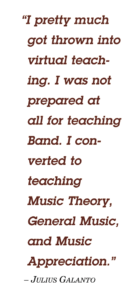 Specialty teachers such as Galanto face different challenges. “I pretty much got thrown into virtual teaching. I was not prepared at all for teaching Band as a large ensemble,” he says. “Towards the end of the last school year I converted to teaching Music Theory, General Music, and Music Appreciation exclusively. This year I am attempting to teach instrumental music. It is a very difficult task since the nature of the band requires a strong group effort and hands-on learning.” Galanto uses the same software and programs as other faculty members and expresses the hurdles in being able to have students play together. “There are specific online music programs that I do plan to utilize. A purchase order of the online programs are to be submitted to gain access for each individual student so it does create an added cost to the school. If the school is unable to fund these programs we would need to fundraise and have our band booster come up with our own funds. Interactive band method books are also on order. Until these additionally purchased products are made available, I have been working on getting connected with the students to build our teacher-student relationship. Things are different now and everything is new to both my teaching and their learning styles. ‘How are you going to teach band online?’ is a common question many of my colleagues have been asking me. Honestly I have no idea since it is not ideal for some students to play at home while they have other family members who may also be attending online classes at the same time. Each of these instruments can get pretty loud (and annoying) for their household. Playing synchronously is also nearly impossible since there is an unavoidable lag. The best I can say is for them to mute their microphones and just play along as I conduct. Another option is for them to practice on their own at a time of their choosing and submit a recording so that I may assess them individually. Either way, it is a huge challenge to overcome. In-person instruction would have allowed me to give immediate assessments and feedback.”
Specialty teachers such as Galanto face different challenges. “I pretty much got thrown into virtual teaching. I was not prepared at all for teaching Band as a large ensemble,” he says. “Towards the end of the last school year I converted to teaching Music Theory, General Music, and Music Appreciation exclusively. This year I am attempting to teach instrumental music. It is a very difficult task since the nature of the band requires a strong group effort and hands-on learning.” Galanto uses the same software and programs as other faculty members and expresses the hurdles in being able to have students play together. “There are specific online music programs that I do plan to utilize. A purchase order of the online programs are to be submitted to gain access for each individual student so it does create an added cost to the school. If the school is unable to fund these programs we would need to fundraise and have our band booster come up with our own funds. Interactive band method books are also on order. Until these additionally purchased products are made available, I have been working on getting connected with the students to build our teacher-student relationship. Things are different now and everything is new to both my teaching and their learning styles. ‘How are you going to teach band online?’ is a common question many of my colleagues have been asking me. Honestly I have no idea since it is not ideal for some students to play at home while they have other family members who may also be attending online classes at the same time. Each of these instruments can get pretty loud (and annoying) for their household. Playing synchronously is also nearly impossible since there is an unavoidable lag. The best I can say is for them to mute their microphones and just play along as I conduct. Another option is for them to practice on their own at a time of their choosing and submit a recording so that I may assess them individually. Either way, it is a huge challenge to overcome. In-person instruction would have allowed me to give immediate assessments and feedback.”

Photo courtesy Jessica Caraang
Another specialty class is ESOL (English to Speakers of Other Languages). Maui-born Jessica Caraang teaches at James Campbell High School on O‘ahu. “The biggest concern I have is for my low-level English speakers. They really need that one on one interaction that I can’t always give them. Even though I allow the students to group up and work independently, like in a real classroom, I can’t actually go up to the struggling student and provide individual support like I’m used to. I tried it with breakout rooms but I can still hear all the other students talking through the speakers in their separate groups. I don’t want to mute them because I want to make sure I can still be attentive to what is going on in their conversations. I love that my students can enjoy their small groups and speak with each other, but breakout rooms for a teacher is basically a cacophony of conversations,” Caraang explains. “Another difficulty I have is that some of my students have low English language proficiencies, and online teaching makes it hard for them to develop their language skills. They need to be able to speak to other students and to watch people’s mouth movements as they speak. There is a lot of lagging with sounds and images when it comes to online meetings.”
Garcia, a former Vice Principal, has been outside of the classroom for fourteen years and is now a Leadership Academy Instructor for 7th and 8th graders at ‘Īao School. He hopes to develop his students in learning leadership skills and be able to participate in organizing leadership activities such as organizing a can food drive for needy families and gathering safety supplies for their school. A few of the difficulties he encountered were technical difficulties and not being able to provide students with the opportunities to practice utilizing the concepts they have learned. “This is a main stumbling block on virtual learning. There are compatibility issues (operating systems, browsers, smart phones, connectivity). The course never gets off the ground and all this adds to the teacher and student frustrations. Secondly, students cannot practice. I believe the best way to learn something is practicing (learning by doing). Many of our online lessons can overlook this part and focus solely on theoretical content and external lessons. I would need to create real life situations or incorporate simulation so students can practice and experiment their virtual learning,” Garcia adds.
At the end of the day, teachers truly miss their students and have been working nonstop to ensure their classrooms receive the best education possible during this trying time.
“Yes, it feels weird to teach to an empty class (physically). In getting to know my fifth graders this past week, how I wish there wasn’t COVID-19 right now,” says Hook. “This experience has tested my patience and passion for teaching. I felt very discouraged and unprepared for the first week of instruction but as I was teaching, something transpired. Seeing the smiles and enjoyment on my students’ faces reminded me that this is why I became a teacher. This experience has also taught me that I’m not alone, anything is possible, and teachers can make things happen.”
In a moment of reflection, Galanto says “I very much feel the need and the care that the students have towards each other and their teachers. As much as the students prior to COVID could not wait for the weekend and extended breaks, they truly miss being in school with their friends and teachers. I have learned that teachers are very resilient. Even with the constant challenges, teachers care way too much and work extremely hard to give their students the best education they can. They are always adapting and find ways to ‘make it work.’ I have learned a lot already on improvising and using computers for my lessons. I have been able to problem solve remotely. I have been able to network with other band teachers both locally and nationally. My successes on overcoming these teaching challenges have been shaping me to become a better mentor to the younger generations of future musicians and teachers.”
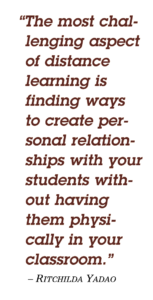 Yadao also emulates wanting to forge relationships with her students. “The most challenging aspect of distance learning is finding ways to create personal relationships with your students without having them physically in your classroom. My biggest fear this year was not being able to establish rapport with my students the same way I could in the physical classroom. I knew this would be challenging but I was convinced that it was not impossible. I want my students to feel my love for them, to know that I care, and to look forward to coming to math class. This just calls for creativity, adaptability, graciousness and kindness. My students have been phenomenal. Their hopeful attitudes, sense of respect for our limited time together and their understanding of why we need to learn this manner has profoundly encouraged me to keep pushing forward. When planning out the school year, I’m naturally worried how my kids would handle this type of learning. Yes, they’re being challenged and so are we as their educators but they are willing to give it a try. That is all I ask of my students. To try, to be open to this new learning opportunity and to be resilient learners.
Yadao also emulates wanting to forge relationships with her students. “The most challenging aspect of distance learning is finding ways to create personal relationships with your students without having them physically in your classroom. My biggest fear this year was not being able to establish rapport with my students the same way I could in the physical classroom. I knew this would be challenging but I was convinced that it was not impossible. I want my students to feel my love for them, to know that I care, and to look forward to coming to math class. This just calls for creativity, adaptability, graciousness and kindness. My students have been phenomenal. Their hopeful attitudes, sense of respect for our limited time together and their understanding of why we need to learn this manner has profoundly encouraged me to keep pushing forward. When planning out the school year, I’m naturally worried how my kids would handle this type of learning. Yes, they’re being challenged and so are we as their educators but they are willing to give it a try. That is all I ask of my students. To try, to be open to this new learning opportunity and to be resilient learners.
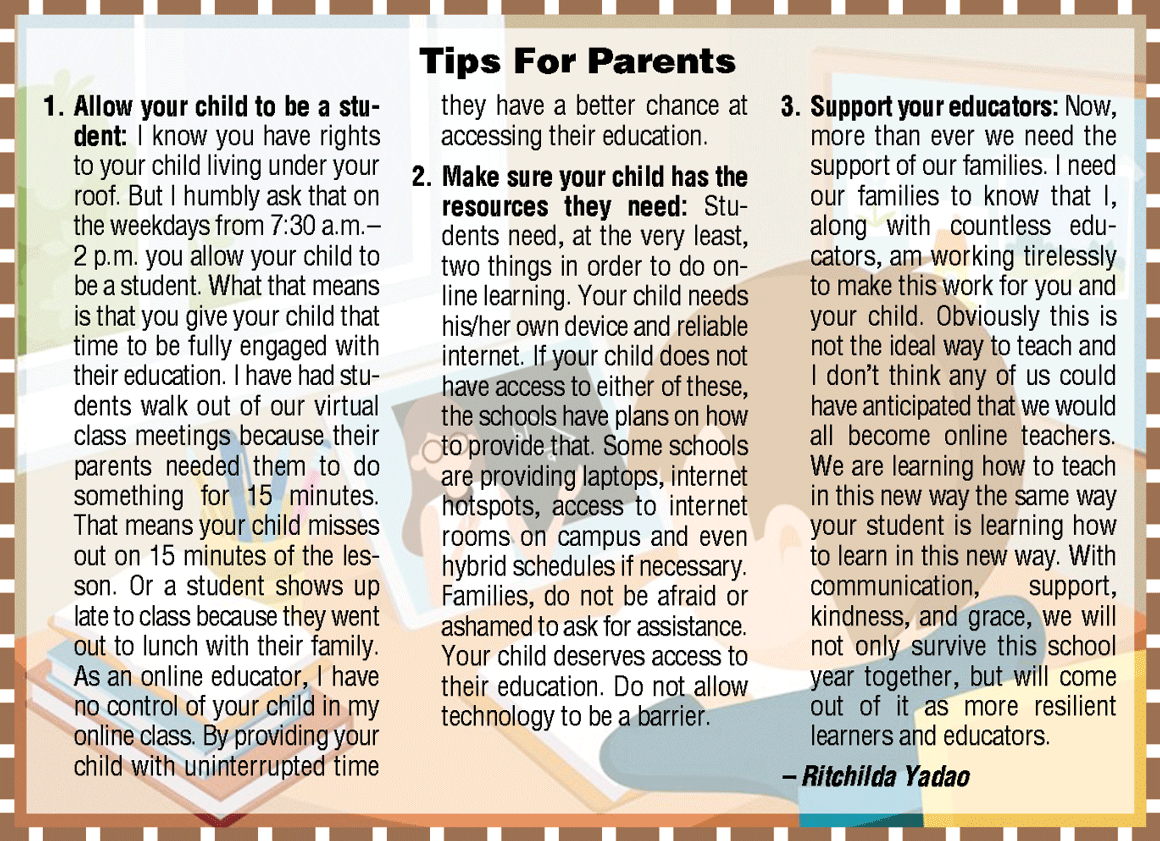
“One thing I did in the past with my students was creating individualized handshakes with each student. This year I’m thinking about individualized voiceshakes. We’ll create a personalized chant together and may add some kind of gesture to it,” says Acidera. “What I have gained from this experience so far is a newfound sense of patience and grace. This may be the most difficult year for some teachers. There will be many obstacles to get through and many mistakes will be made but if we can forgive ourselves, adjust, and improve, then I think we will be fine. This also goes with our students and parents. We need to remember that this is experience for them too. We shouldn’t expect them to know everything and we should also be mindful of their current situation, as the pandemic affected every family differently.”
 Vanessa Joy Domingo is a graduate of Maui High School and is employed with the County of Maui – Department of Management, IT Services and Coldwell Banker as a Realtor. She thanks the educators who shaped her throughout her years as a student of Kahului Elementary School, Maui Waena Intermediate School, and Maui High School. She still talks to her teachers once in a while to this day—some of whom continue to be involved in her life and are her friends on Facebook.
Vanessa Joy Domingo is a graduate of Maui High School and is employed with the County of Maui – Department of Management, IT Services and Coldwell Banker as a Realtor. She thanks the educators who shaped her throughout her years as a student of Kahului Elementary School, Maui Waena Intermediate School, and Maui High School. She still talks to her teachers once in a while to this day—some of whom continue to be involved in her life and are her friends on Facebook.
